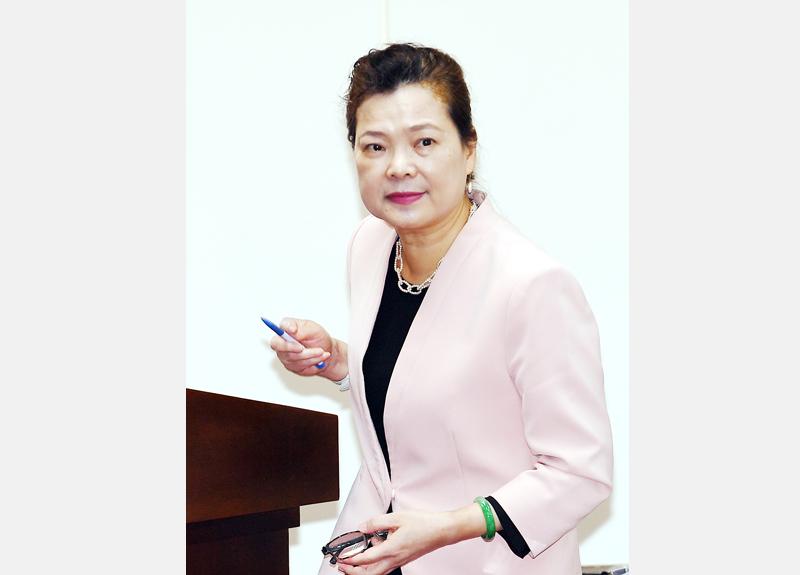Taiwan will find its own way, despite not being a part of the Regional Comprehensive Economic Partnership (RCEP), Minister of Economic Affairs Wang Mei-hua (王美花) said yesterday.
Fifteen Asia-Pacific nations — the 10 ASEAN members, as well as Australia, China, Japan, New Zealand and South Korea — signed the trade deal on Sunday. The members together account for about one-third of the world’s GDP.
Responding to media reports that Taiwan would be left “out in the cold” or “marginalized economically” after the signing of the RCEP, Wang said the effects of the deal would not be “overwhelming” or “immediate.”

Photo: CNA
“After going through the details it seems that the level of trade liberalization with the RCEP is relatively low,” Wang said. “We do not think it will have a large impact on Taiwanese businesses in the short term.”
“However, of course, we will communicate as soon as possible with business leaders in affected industries to figure out how to improve our competitiveness,” she said.
The local industries that are most likely to be affected are steel, petrochemicals, machinery and textiles, Wang said.
Although subsidies are not being considered, the ministry is open to “helping Taiwanese businesses with research and development,” she said.
The impact of the RCEP is lessened by the fact that many of the signatory nations already have free-trade agreements (FTAs) in place, and many “sensitive items” are not included in the list of goods affected by the deal, Wang said.
“Most of the ASEAN countries already have FTAs with Japan, South Korea and China, and the RCEP does not go far beyond those FTAs in terms of cutting tariffs,” she said. “The bigger deal is, with the RCEP, China and Japan now effectively have an FTA, as do South Korea and Japan.”
Wang said that some items “sensitive to Taiwan,” such as machine tools and upstream materials for nylon fabric, were not liberalized.
“Some of the items we find sensitive are also sensitive to China,” Wang added.
She said that it would have been politically insupportable for Taiwan to try and gain entry into the Beijing-driven RCEP.
“If we had pursued our inclusion in [the RCEP], we would have required the consent of all the countries, including China,” Wang said. “As a condition, China would have certainly demanded that Taiwan agree to the ‘1992 consensus.’ Is this something our people can live with?”
Citing the strength of Taiwanese manufacturers, Wang said Taiwan would strive to participate in other trade deals, including the Comprehensive and Progressive Agreement for Trans-Pacific Partnership.
“We are still protected by the Informational Technology Agreement under the WTO, and this ensures that more than half of our exports are tariff-free,” she said.
“When one path is blocked off, we will find another way through,” Wang added.
The “1992 consensus” — a term former Mainland Affairs Council chairman Su Chi (蘇起) in 2006 admitted making up in 2000 — refers to a tacit understanding between the Chinese Nationalist Party (KMT) and the Chinese Communist Party that both sides acknowledge there is “one China,” with each side having its own interpretation of what “China” means.

Taiwan’s long-term economic competitiveness will hinge not only on national champions like Taiwan Semiconductor Manufacturing Co. (TSMC, 台積電) but also on the widespread adoption of artificial intelligence (AI) and other emerging technologies, a US-based scholar has said. At a lecture in Taipei on Tuesday, Jeffrey Ding, assistant professor of political science at the George Washington University and author of "Technology and the Rise of Great Powers," argued that historical experience shows that general-purpose technologies (GPTs) — such as electricity, computers and now AI — shape long-term economic advantages through their diffusion across the broader economy. "What really matters is not who pioneers

In a high-security Shenzhen laboratory, Chinese scientists have built what Washington has spent years trying to prevent: a prototype of a machine capable of producing the cutting-edge semiconductor chips that power artificial intelligence (AI), smartphones and weapons central to Western military dominance, Reuters has learned. Completed early this year and undergoing testing, the prototype fills nearly an entire factory floor. It was built by a team of former engineers from Dutch semiconductor giant ASML who reverse-engineered the company’s extreme ultraviolet lithography (EUV) machines, according to two people with knowledge of the project. EUV machines sit at the heart of a technological Cold

TAIWAN VALUE CHAIN: Foxtron is to fully own Luxgen following the transaction and it plans to launch a new electric model, the Foxtron Bria, in Taiwan next year Yulon Motor Co (裕隆汽車) yesterday said that its board of directors approved the disposal of its electric vehicle (EV) unit, Luxgen Motor Co (納智捷汽車), to Foxtron Vehicle Technologies Co (鴻華先進) for NT$787.6 million (US$24.98 million). Foxtron, a half-half joint venture between Yulon affiliate Hua-Chuang Automobile Information Technical Center Co (華創車電) and Hon Hai Precision Industry Co (鴻海精密), expects to wrap up the deal in the first quarter of next year. Foxtron would fully own Luxgen following the transaction, including five car distributing companies, outlets and all employees. The deal is subject to the approval of the Fair Trade Commission, Foxtron said. “Foxtron will be

INFLATION CONSIDERATION: The BOJ governor said that it would ‘keep making appropriate decisions’ and would adjust depending on the economy and prices The Bank of Japan (BOJ) yesterday raised its benchmark interest rate to the highest in 30 years and said more increases are in the pipeline if conditions allow, in a sign of growing conviction that it can attain the stable inflation target it has pursued for more than a decade. Bank of Japan Governor Kazuo Ueda’s policy board increased the rate by 0.2 percentage points to 0.75 percent, in a unanimous decision, the bank said in a statement. The central bank cited the rising likelihood of its economic outlook being realized. The rate change was expected by all 50 economists surveyed by Bloomberg. The